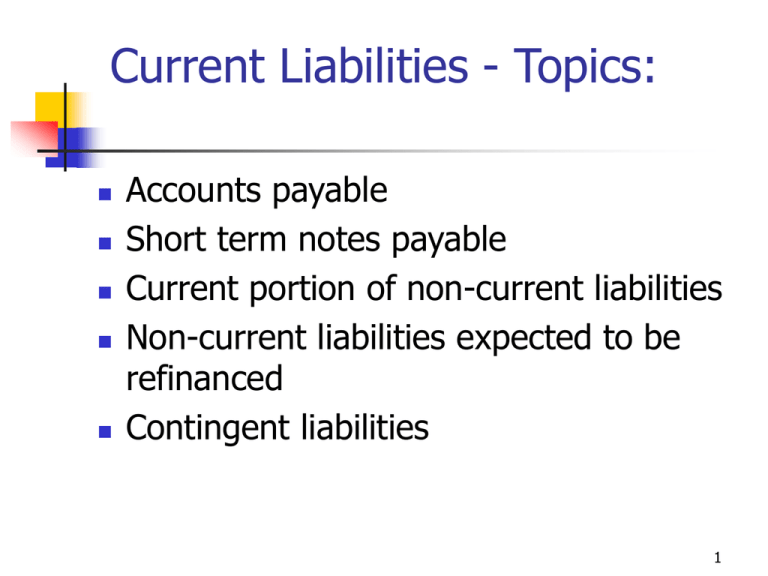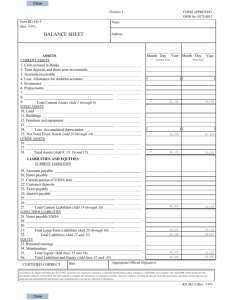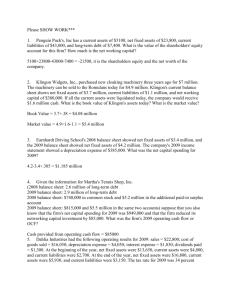Current Liabilities
advertisement

Current Liabilities - Topics: Accounts payable Short term notes payable Current portion of non-current liabilities Non-current liabilities expected to be refinanced Contingent liabilities 1 Current Liabilities - examples: Accounts payable Salaries payable – see slides at end deferred revenue (can be current and/or non-current) Current portion of taxes payable 2 Current Liabilities: Accounts payable etc., expected to pay very quickly ---- interest should not be an issue Notes payable: probably include interest. Make sure interest is calculated and recognized properly 3 Note Payable (Current): 60 day, 8% note payable issued 12/1/02, $ 10,000. Dr. purchases $10,000 cr. Note payable $ 10,000 On 12/31: determine and recognize interest : 10,000 * .08 * 30/360 = $67 Dr. interest expense cr. Interest payable $67 $67 4 Current portion of non-current liabilities As non-current liabilities mature, they must be reported as current. Also, if in default! Useful info or detrimental distraction? Useful info IF debt will really be paid in the coming period. E.g., current portion of income taxes payable. Not useful, if debt will be refinanced therefore: 5 Current portion of non-current debt to be refinanced Special Rule: If company has the intent AND the ability to refinance debt (e.g., issue new bonds to repay old bonds) then “current portion of non-current debt to be refinanced” is shown in separate section between current and non-current liabilities 6 Current portion of non-current debt to be refinanced Conditions that must be met: Company must be able to demonstrate that it has the Ability to refinance debt: Completed negotiations to issue new debt Already issued new debt (after end of fiscal year, but before financial statements issued) 7 Contingent Liabilities Potential liabilities – triggered by some specified future event. Rule: If the trigger event is probable and the amount can be determined -- accrue the liability If the potential liability is expected to be material, but the amount cannot be estimated, disclose in footnote 8 Example: Warranties Both probable and can be estimated -- accrue when sales made: Based on experience, warranty costs resulting from current sales should total $15,000. Journal entry: Dr. Warranty expense $15,000. Cr. Warranties (liability) $15,000. 9 Example: Coupons, Premiums, Frequent Flyer Miles, Etc. Essentially treated the same as warranties: Based on past experience, X% of (whatever) will be redeemed at Y cost. The amount can be estimated and must be accrued as a liability (some may be non current, most current). Journal entry depends. I.e., coupons - advertising expense; miles reduction of revenue recognized 10 Example: Environmental Liabilities: contingent liability must be accrued If company named as a PRP (partially responsible party) by the EPA If company activities require future mitigation (cleanup, reactor shut downs etc.) 11 Example: Lawsuit (not potentially material) Unless there is no likelihood of winning, NEVER accrue lawsuit liability. Instead: Footnote – general for run of the mill lawsuits: XYZ company is party to several legal actions in which we expect to prevail. Even if they should result in a negative verdict we do not expect them to have a material effect on the company 12 Lawsuit (amount potentially material) Footnote: The company is being sued for $50 million for alleged racial discrimination. We deny the charges and expect to prevail. Even if we should not prevail we do not believe that this case would have a material effect on the company. 13 Lawsuit (material, will probably lose) Company may chose to accrue liability to force the action into bankruptcy court. This applies to unusual situations, original case: Johns Manville (The granddaddy of asbestos litigation) Company accrued the potential liability, triggered debt/equity covenants – led to technical bankruptcy, etc. 14 Lawsuit (material, will probably lose) II Other examples: Dow Corning (Breast implants) Dalkon Shield Not to be done unless the technical bankruptcy route is really considered the only option. 15 Asset Retirement Obligation (ARO) Arises in connection with certain asset acquisitions Strip mine Power plants Land fill (dump) Conditions imposed with operating permits that require certain actions to clean up after operations/use completed 16 Asset Retirement Obligation (ARO) Expected cost is discounted (PV) and capitalized and then amortized (expensed) over the life of the asset Example: Strip mining concession Condition: restore land to original condition – expected cost: $500,000 Life: 50,000 tons of coal; 3 years 17 ARO Strip mine continued expected cost: $500,000, discount rate 10%, 3 years: PV(3,10%) .751 = $375,500 Journal entry: Dr. Strip mine $375,500 cr. Asset retirement obligation $375,500 18 ARO Strip mine continued Amortization: $375,500/50,000 ton = $7.51 per ton 10,000 tons mined: Journal entry: Dr. depreciation expense $75,100 cr. Accumulated depreciation $75,100 19 ARO Strip mine continued Accrual of interest expense: $375,500 *.1 = 37,550 Journal entry: Dr. interest expense expense cr. Asset retirement obligation $37,550 $37,550 20 Payroll related current liabilities I 1. 2. Salaries earned, not yet paid Benefits earned (vested) 1. 2. Compensated absences (sick leave, vacation) Pensions Accrue as earned (i.e., 2 hours per week) Dr. compensation expense xxx cr. Compensated absences (vacation, sick days) xxx 21 Payroll related current liabilities II Payroll deductions 1. 2. 3. 4. 5. Social security taxes Income taxes (state, federal, local) Unemployment tax Workman’s compensation Other deductions (parking, union dues, 401k contributions) 22 Payroll related current liabilities III Note that some of these are subtracted from salaries earned, employer acts as collection agency for government or other agencies: Examples: Income taxes, union dues, 401k contributions, other employee savings (deductions) programs, employee social security contribution. 23 Payroll related current liabilities IV Other items are paid by the employer directly (i.e., NOT deducted from cash received by employee) Examples: Unemployment tax Employer portion of social security contribution Pension, vacation, sick pay Workman’s compensation 24






